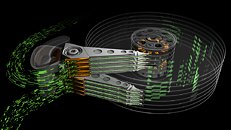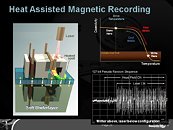Tuesday, December 19th 2017

Seagate Bringing RAID 0 Performance to Single HDD via Multi-Actuator Tech
Seagate may currently be one of the first tech companies in storage conversations due to their upcoming HAMR (Heat-Assisted Magnetic Recording) technology, which should enable 20 TB HDDs by 2020. And even though HDDs are better known for their high areal density and price/storage ratio, which is only bound to increase through the usage of HAMR, Seagate knows that areal density is hardly one of the principal bottlenecks in HDD technology. The bottleneck, as it usually is, is speed.
HDDs have an old design philosophy by now, where an actuator arm moves read/writing heads in parallel across the surface of the disk - nowadays, there are usually two heads per platter (one on the upper side, and one on the underside of it). As you might image, a given head can either read or write at one point in time - and all heads move in tandem, with different heads reading or writing across the multiple spinning discs that constitute the hard drive. This, however, means that HDD reading efficiency is lost - due to how small the 1s and 0s are on HDDs, only one head can be moved to an exact data path, with all the others moving with it, spending power and increasing the load on the actuator for nary a speed gain or minimal workload.Seagate's solution is ingeniously simple (for us laymen looking from the outside in, naturally). Seagate is planning to install not one, but two actuator arms in HDDs, which would work entirely separately. Naturally, still only one head in each actuator would be able to read or write at any point in time, but nevertheless, this implementation would mean that there can be two HDD sections being operated on at the same time, effectively allowing for double the read and write speeds. This isn't much too different from RAID 0 configurations, really - where data from a single HDD is mirrored across two HDDs, which guarantees that the heads of each HDD can both be reading/writing the same data, thus doubling read and write speeds. This implementation by Seagate could either allow for an intra-disk RAID 0 array - or simply for a bolster to an HDD's ability to simultaneously read and write, without any performance loss - if the data you're reading and writing are on the platters supported by different actuators, naturally."Seagate Hard Drives are about to embark on a new exponential growth in capacity with the introduction of EAMR technologies like HAMR [Heat-Assisted Magnetic Recording]," said Aaron Ogus, Microsoft Azure Storage Architect. "In most datacenter applications the additional capacity gains cannot be effectively utilized without improvements in device IO capacity. The dual actuator technology helps unlock additional IOPS [input/output operations per second] and allows cloud providers to make effective use of the new capacity gains."Seagate says the drives could use SAS, SATA, or NVMe interfaces, which is a boon for all kind of customers, be them enterprise or consumers. Closing this article up, this editor would like to say that these are probably the most interesting times in HDD's life in decades now. The medium really hasn't evolved all that much since its inception. However, we are now on the verge of seeing the two greatest HDD manufacturers, WD and Seagate, coming out of the gates with different technologies for the medium. HAMR and MAMR (Microwave-Assisted Magnetic Recording) can either be great for customers, with increased product differentiation according to a users' needs, or might result in one company struggling much more than the other, considering implementation difficulties of each technology. Now, with the double-actuator design that Seagate is presenting, it seems we'll have another point of differentiation sometime in the future - though this seems more like a safe bet for all manufacturers to adopt, should it prove worthy of the investment. Fun times.
Source:
Seagate Blog
HDDs have an old design philosophy by now, where an actuator arm moves read/writing heads in parallel across the surface of the disk - nowadays, there are usually two heads per platter (one on the upper side, and one on the underside of it). As you might image, a given head can either read or write at one point in time - and all heads move in tandem, with different heads reading or writing across the multiple spinning discs that constitute the hard drive. This, however, means that HDD reading efficiency is lost - due to how small the 1s and 0s are on HDDs, only one head can be moved to an exact data path, with all the others moving with it, spending power and increasing the load on the actuator for nary a speed gain or minimal workload.Seagate's solution is ingeniously simple (for us laymen looking from the outside in, naturally). Seagate is planning to install not one, but two actuator arms in HDDs, which would work entirely separately. Naturally, still only one head in each actuator would be able to read or write at any point in time, but nevertheless, this implementation would mean that there can be two HDD sections being operated on at the same time, effectively allowing for double the read and write speeds. This isn't much too different from RAID 0 configurations, really - where data from a single HDD is mirrored across two HDDs, which guarantees that the heads of each HDD can both be reading/writing the same data, thus doubling read and write speeds. This implementation by Seagate could either allow for an intra-disk RAID 0 array - or simply for a bolster to an HDD's ability to simultaneously read and write, without any performance loss - if the data you're reading and writing are on the platters supported by different actuators, naturally."Seagate Hard Drives are about to embark on a new exponential growth in capacity with the introduction of EAMR technologies like HAMR [Heat-Assisted Magnetic Recording]," said Aaron Ogus, Microsoft Azure Storage Architect. "In most datacenter applications the additional capacity gains cannot be effectively utilized without improvements in device IO capacity. The dual actuator technology helps unlock additional IOPS [input/output operations per second] and allows cloud providers to make effective use of the new capacity gains."Seagate says the drives could use SAS, SATA, or NVMe interfaces, which is a boon for all kind of customers, be them enterprise or consumers. Closing this article up, this editor would like to say that these are probably the most interesting times in HDD's life in decades now. The medium really hasn't evolved all that much since its inception. However, we are now on the verge of seeing the two greatest HDD manufacturers, WD and Seagate, coming out of the gates with different technologies for the medium. HAMR and MAMR (Microwave-Assisted Magnetic Recording) can either be great for customers, with increased product differentiation according to a users' needs, or might result in one company struggling much more than the other, considering implementation difficulties of each technology. Now, with the double-actuator design that Seagate is presenting, it seems we'll have another point of differentiation sometime in the future - though this seems more like a safe bet for all manufacturers to adopt, should it prove worthy of the investment. Fun times.




27 Comments on Seagate Bringing RAID 0 Performance to Single HDD via Multi-Actuator Tech
So for the time being, HDD's are still the way to go if you need any decent capacity for reasonable prices. So finding new ways to make HDD's work better/faster is still a very much welcome and needed advancement.